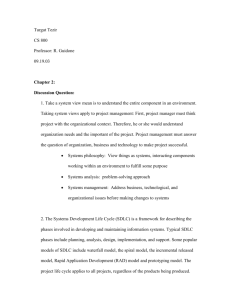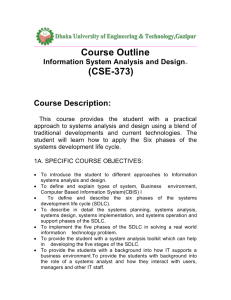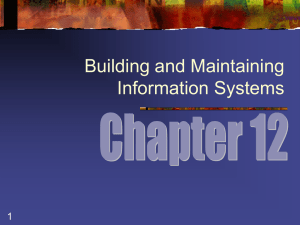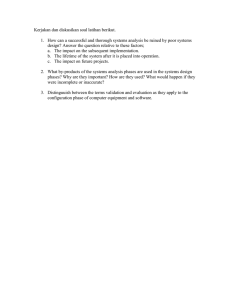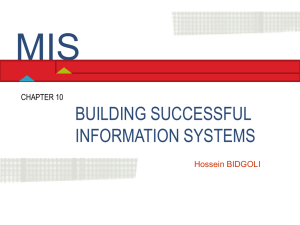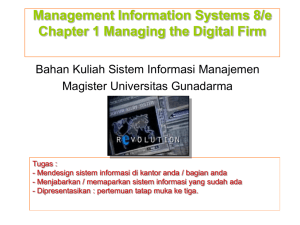Pertemuan 9 Membuat dan mengelola sistem informasi Matakuliah
advertisement
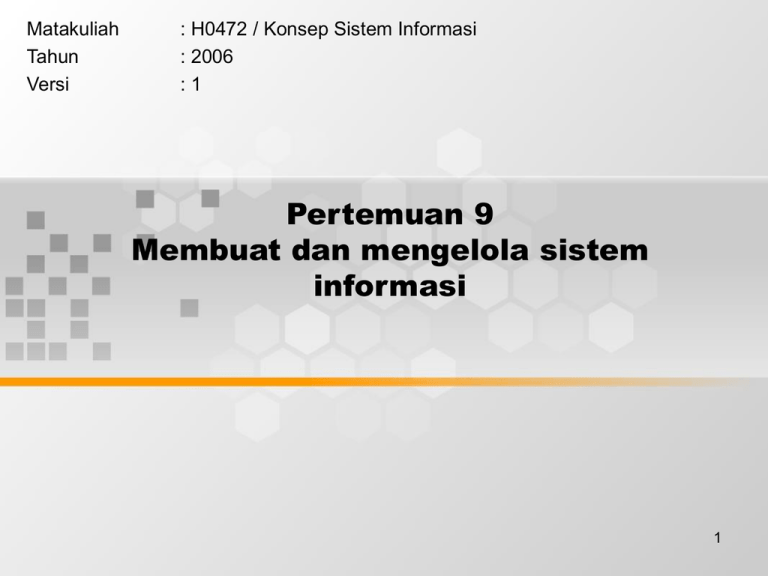
Matakuliah Tahun Versi : H0472 / Konsep Sistem Informasi : 2006 :1 Pertemuan 9 Membuat dan mengelola sistem informasi 1 Learning Outcomes Pada akhir pertemuan ini, diharapkan mahasiswa akan mampu : • Menjelaskan proses pembuatan dan mengelola sistem. 2 Outline Materi • Membuat sistem informasi menggunakan tradisional sistem. • Prototype • Application Package • End user development 3 Building and Maintaining Information Systems • Phases of information systems • Alternative approaches for building information systems • Traditional SDLC • Prototypes • Application Packages • End-User Development • How to choose which methods to use? 4 Introductory case (Microsoft)… • “Big system” development • How does this compare to small, focused projects? • How does this compare to the open source philosophy? 5 Phases of any information system • Remember these? From the first chapter, and it was a mid-term question… • Phases (generically speaking) – Initiation – Development – Implementation – Operation and maintenance 6 Cost of errors, based on time of detection 7 How are these phases linked? 8 Alternative approaches for building systems • Approaches – Traditional SDLC – Prototypes – Application Packages – End-user development • Let’s look at each of these in more detail… 9 What are the differences? TRADITIONAL SYSTEM LIFE CYCLE Issue addressed: Control Summary: Go through a fixed sequence of steps with signoffs after each step and careful documents. PROTOTYPE Issue addressed: Knowledge Summary: Quickly develop a working model of the system; use the model to gain experience and decide how the final system should operate. APPLICATION PACKAGES Issue addressed: Resources and timing Summary: Purchase an existing information system from a vendor; customize the system if necessary. END USER DEVELOPMENT Issue addressed: Responsiveness Summary: Provide tools and support that make it practical for end users to develop their own information systems. 10 Traditional SDLC • Initiation – Feasibility study • Economic, technical and organizational – Functional spec – Project plan • Development – Look at the diagram on the next slide… 11 Steps in Development 12 Formal development in action… • The IMS project 13 Traditional SDLC • Implementation – Is there a similar breakdown of tasks? 14 Implementation 15 Traditional SDLC • Operation and maintenance 16 Prototypes • Phases • Advantages & disadvantages – Used when there is not a clear picture of what is needed in a system – Iterative “quick & dirty” mockups 17 Prototype phases… INITIATION Users and developers agree to develop a prototype because they need experience with a working model before designing a final system. DEVELOPMENT Working iteratively with users, a prototype is developed and improved. Later, decide whether to complete the prototype or switch to a traditional life cycle. IMPLEMENTATION Accomplish parts of implementation along with development as users work with the prototype system. Dispel skepticism about whether the system will meet users’ needs. OPERATION AND MAINTENANCE May be similar to a traditional life cycle. May require less maintenance because the system fits users’ needs more accurately. May require more maintenance because the system is not constructed as well. 18 Prototypes – iterative development 19 Application packages (COTS) • Phases • Advantages & disadvantages 20 Application package phases INITIATION May start with user’s or manager’s recognition of a business problem or with a sales call from a vendor. DEVELOPMENT The vendor develops the software, although the purchase still performs some typical development activities, such as determining detailed requirements. Development may include customization of the software and user documentation. IMPLEMENTATION Implementation starts by deciding exactly how the package will be used. It often relies on the vendor’s staff because they have the greatest knowledge of the system. OPERATION AND MAINTENANCE Operation occurs as it would with a traditional life cycle. Maintenance is different because the vendor maintains the software based on requests from customers and demands of the market. 21 Selecting an application package A APPLICATION FEATURES completeness quality of reports ease of use documentation TECHNICAL FEATURES use of DBMS transportability expandability VENDOR COMPARISON financial strength management strength committment to product ECONOMIC COMPARISON purchase price maintenance contract consulting charges conversion cost Total weighted score B C A B C WEIGHT 2.5 1.0 2.3 2.8 SCORE 9 7 9 5 5 9 3 9 8 9 6 7 WEIGHTED SCORE 22.5 17.3 20.0 9.0 5.0 9.0 11.5 20.7 19.6 8.4 25.2 19.6 2.8 0.8 1.2 8 2 4 7 5 5 3 6 5 22.4 1.6 4.8 19.6 4.0 6.0 8.4 4.8 6.0 2.0 1.3 2.6 9 6 4 7 9 7 5 8 9 18.0 7.8 10.4 14.0 11.7 18.2 10.0 10.4 23.4 2.0 1.5 0.6 2.3 7 7 5 5 5 7 6 3 7 8 8 5 14.0 10.5 3.0 11.5 10.0 10.5 3.6 6.9 14.0 12.0 4.8 11.5 155.4 172.9 167.7 22 End-user development • Phases • Supporting the users • Advantages & disadvantages 23 End-user system phases INITIATION Because the user will develop the information system, a formal functional specification is unnecessary. DEVELOPMENT The user develops the system using tools that do not require a professional level of programming knowledge. Information systems that are critical to the company or have many users require more extensive testing, documentation, and usage procedures. IMPLEMENTATION Implementation is simplified because the developer is the user. OPERATION AND MAINTENANCE End users are responsible. Long-term maintenance and technical quality become larger issues because the end users have other work to do and are not professional programmers. 24 Deciding which methods to use • Comparing… • Synthesizing to get the right balance… – It’s not all or nothing 25 Closing • Membuat sistem informasi menggunakan tradisional sistem. • Prototype • Application Package • End user development 26
